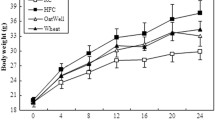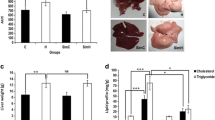Summary.
Background:
Research has focussed on the hypocholesterolemic effects of certain types of dietary fiber such as enhancing conversion of hepatic cholesterol to bile acids or increase in catabolism of low density lipoprotein (LDL) via the apo B,E receptor.
Aim of the study:
The effect of oral administration of a unique fibre cocktail of fenugreek seed powder, guar gum and wheat bran (Fibernat) and its varied effects on some aspects of lipid metabolism and cholesterol homeostasis in rats were examined.
Methods:
Rats were administered Fibernat along with the atherogenic diet containing 1.5 % cholesterol and 0.1 % cholic acid. Amounts of hepatic lipids, hepatic and fecal bile acids and activity of hepatic triglyceride lipase (HTGL) were determined. Transmission electron microscopic examination of the liver tissue and extent of uptake of 125I-LDL and 125I-VLDL by the hepatic apo B,E receptor was carried out.
Results:
Food intake and body weight gain were similar between the 3 different dietary groups. Fibernat intake significantly increased apo B,E receptor expression in rat liver as reflected by an increase in the maximum binding capacity (Bmax) of the apo B,E receptor to 125I-LDL and 125I-VLDL. The activity of HTGL was increased by approximately 1.5-fold in Fibernat-fed rats as compared to those fed the atherogenic diet alone. A marked hypocholesterolemic effect was observed. Cholesterol homeostasis was achieved in Fibernat-fed rats.
Conclusion:
Two possible mechanisms are postulated to be responsible for the observed hypocholesterolemic effect a) an increase in conversion of cholesterol to bile acids and b) possibly by intra-luminal binding which resulted in increased fecal excretion of bile acids and neutral sterols. The resulting reduction in cholesterol content of liver cells coupled with upregulation of hepatic apo B,E receptors and increased clearance of circulating atherogenic lipoproteins—LDL and very low density lipoprotein (LDL and VLDL)—is the main mechanism involved in the hypocholesterolemic effect of Fibernat. The results suggest that Fibernat’s effect on plasma LDL concentration is also possibly mediated by increased receptor-mediated catabolism of VLDL. Thus, Fibernat therapy is an effective adjunct to diet therapy and might find potential use in the therapy of hyperlipidemic subjects.
Similar content being viewed by others
Author information
Authors and Affiliations
Rights and permissions
About this article
Cite this article
Venkatesan, N., Niranjali Devaraj, S. & Devaraj, H. Increased binding of LDL and VLDL to apo B,E receptors of hepatic plasma membrane of rats treated with Fibernat. Eur J Nutr 42, 262–271 (2003). https://doi.org/10.1007/s00394-003-0420-8
Received:
Accepted:
Issue Date:
DOI: https://doi.org/10.1007/s00394-003-0420-8




